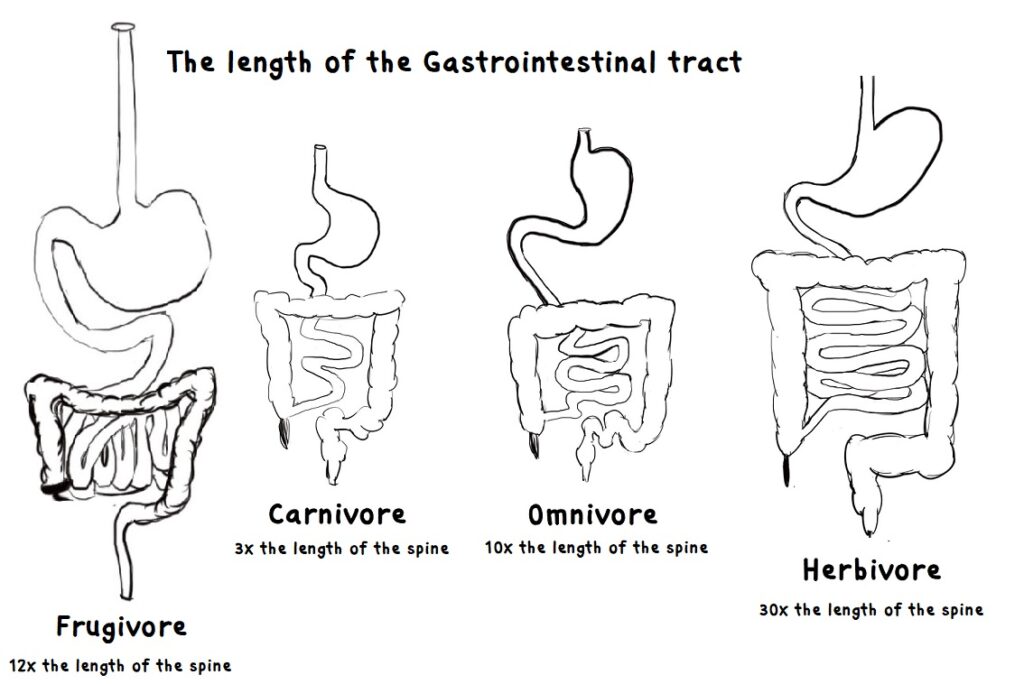Here are the summarized characteristics of each vertebrate category and their corresponding diets:
- Carnivores:
- Diet: Mainly meat, along with some vegetables, grass, and herbs.
- Digestive system: Rough tongue for pulling and tearing, no salivary glands, simple stomach structure with strong gastric juices, smooth and short small intestines, large and complex liver with five distinct chambers, minimal absorption ability in the smooth colon, and a gastrointestinal tract three times the length of the spine.
- Extremities: Claw-type hands and feet, walking on all four limbs.
- Integumentary system: Skin covered with hair, sweat glands present in foot pads only.
- Skeletal system: Incisor teeth in front, molars behind, large canine teeth for ripping, unidirectional jaw movement (up and down), and a tail.
- Urinary system: Kidneys produce acidic urine.
- Omnivores:
- Diet: Some meat, vegetables, fruits, roots, and some barks.
- Digestive system: Moderate to rough tongue, underactive salivary glands, moderate gastric acids in the stomach, somewhat sacculated small intestines, a complex and proportionally larger liver, a colon shorter than the human colon with minimal absorption, and a gastrointestinal tract ten times the length of the spine.
- Extremities: Hoofs, claws, or paws for hands and feet, walking on all four limbs except for birds.
- Integumentary system: Smooth and oily skin with hair or feathers, minimal sweat glands, only around snout or foot pads.
- Skeletal system: Tusk-like canine teeth or beaks, multidirectional jaw movement, and a tail.
- Urinary system: Kidneys produce acidic urine.
- Herbivores:
- Diet: Vegetables, herbs, some roots, and barks.
- Digestive system: Moderately rough tongue, alkaline salivary glands for digestion initiation, an oblong and ringed stomach with weak stomach acids, long and sacculated small intestines for extensive absorption, a liver similar to humans but slightly larger in capacity, a long and sacculated colon for extensive absorption, and a gastrointestinal tract thirty times the length of the spine.
- Extremities: Hoofs, claws, or paws for hands and feet, walking on all four limbs.
- Integumentary system: Skin with extensive hair covering the entire body, millions of sweat glands for perspiration.
- Skeletal system: Twenty-four molars, eight incisors in the front, multi-directional jaw movement, and a tail.
- Urinary system: Kidneys produce alkaline urine.
- Frugivores (including humans and primates):
- Diet: Mainly fruits, nuts, seeds, sweet vegetables, and herbs.
- Digestive system: Smooth tongue used as a shovel, alkaline salivary glands for digestion initiation, an oblong stomach with two compartments, long and sacculated small intestines for extensive absorption, a simple and average-sized liver, a long and sacculated colon for extensive absorption, and a gastrointestinal tract twelve times the length of the spine.
- Extremities: Hands (upper) for picking, peeling, and tearing, feet (lower) with toes for walking upright on two extremities.
- Integumentary system: Skin with minimal hair and millions of sweat glands for perspiration.
- Skeletal system: Thirty-two teeth with incisors, cuspids, small molars, and no long canine or tusk-type teeth, multi-motional jaw movement, and some species have a tail.
- Urinary system: Kidneys produce alkaline urine.

Upon examining the anatomical and physiological characteristics of vertebrates, it becomes apparent that frugivores, including humans, share the most resemblances. The size and complexity of the liver, the length of the gastrointestinal tract, and the structure of teeth are distinct factors that indicate frugivores are not designed for consuming meat, in contrast to carnivores. Even compared to omnivores, the length of the human gastrointestinal tract is not optimized for efficiently processing and eliminating meat. Our design, including a long and sacculated colon, may make it challenging to eliminate undigested meat effectively.
Observing the animal kingdom, it is notable that animals thrive in harmony with their environment without the need for hospitals or prescription medications. When they do get sick, they instinctively know what to do, often resorting to fasting. Humans, on the other hand, have lost their connection to nature and face confusion regarding the ideal diet for reversing chronic illnesses, promoting vibrancy, and thriving. This confusion can be attributed to the influence of big pharmaceutical companies and the education provided to medical doctors.
While it is disheartening to witness the prevalence of chronic illnesses, as a practitioner, it motivates me to emphasize the path of higher conscious living and the consumption of electric foods such as fruits and herbs. By following this path, we can reverse chronic illnesses, achieve vibrant health, and thrive on a daily basis. This is the sole objective of my efforts.
These distinctions help us understand the anatomical and physiological characteristics of each vertebrate category and their corresponding
